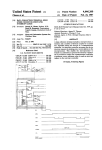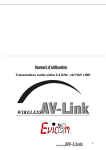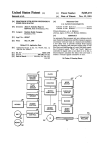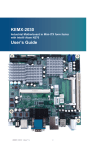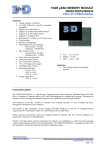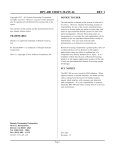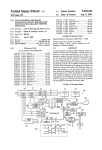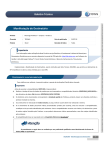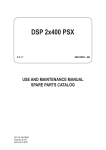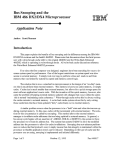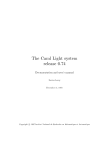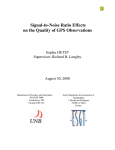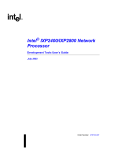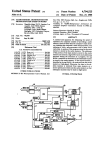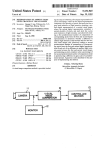Download New aw . e
Transcript
United States Patent [191
[11]
Patent Number:
4,669,057
Clark, Jr. et a1.
[45]
Date of Patent
* May 26, 1987
[54]
[56]
DATA COLLECTION TERMINAL
INTERRUPT STRUCTURE
[75] Inventors: Vincent M. Clark, Jr., Tyngsboro;
David R. Bourgeois, Framingham;
w
m
e
.
[57]
t9'
eN
4.
w
N.
H.
l_.[.l257wl
.m
m
M
m
mSe-m.
.n.w:
dC
O.
m
..
mm
6,J”W3ms
m"W
Twd5Ohbmd0a8nwwm
t
.8 h3
mm2? n
ma,0M
m
.mm
F
mm
m.
mer.“8
Ht3un3000cm$fm
d.lneu9, IM
H6
m
1.
otd.m8l
m
w.
n
PS81.ab1.Ite/nmm
m.
e
3
n.l
.
J.m
n S
ABSTRACT
A data collection terminal includes a microprocessor, a
memory and a number of devices coupled to a system
bus. An interrupt controller processes the device inter
rupt requests by sending a vector address out on the
system bus to enable the microprocessor to branch to a
microprogram to process the interrupt request. Appara
tus is provided to receive the vector address to generate
an interrupt clear signal for those interrupts which are
transitory in nature. Typical examples are a document
being inserted in a device or a card seated in a device.
I
[52] us. 01.
[58] Field of Search
364/200
Hualm_ks“ReJameawNew
r
Dennis W. Chasse, Nashau; Todd R.
Comins, Chelmsford, all of Mass.
c.. n
l
References Cited
U.S. PATENT DOCUMENTS
364/900
364/200 MS File, 900 MS File
13 Claims, 3 Drawing Figures
.l.|lIL|l
U. S. Patent May26, 1987
Sheet2 of6
4,669,057
P76. 2
SHEET l OF4
OR DRST
|NTENB+
A
-
+
|OMEM*
IOMEM -
3-36
1on0
DTREC+
IOMEM‘
U
T
3_38
SR
0
p
U. S. Patent May 26, 1987
vwx
______
r
___
__
SheetS of6
4,669,057
z
___-
___
__________
_
____________-_
-1
551
cc~00w
I
'
I
55
.
as
,
I
I
l
|
[Ha-4
,
mac-7+
INT
'a
moo
AO+
IORD_
I
IOWR—
|8_5
4
mm
Y9-
34
can
I
7
Cl
TED
'
|
I
l
MULTIFUNCTION
g] 3 C05
|NTA_
hi‘!
51%
J
.'
I
I
mm‘
READER
cp
I
I
LOGIC
:
as
C—s
I
5
I
|
7
“X
,
5
‘Ti
ENE
I8-6
|
TREN-
'
ENI
I
I
'2
I
I
I
I
ll
{3
:
I
l
|
|
l
l
l
l
I
I
l
|
|
l
I
I
I
LL
I
l
I
_
_
_
_
_
_
_
_
_
_
_
_
_
_
Q
_
_
_
_
_
_
__
_
__
__
_,___
5--_
F76 2
SHEET 4 OF 4
I
_________-__________
U. S. Patent May26, 1987
Sheet6 of6
BACKGROUND
INI'ERRUPT
INTR+
INTA
l
r86
INTA
88
RECEIVE
VECTOR
ADDRESS
90
BRANCH
TD
RDUTINE
PROCESS
/92
INTERRUPT
F/G. 3
WRITE SIGNAL
I/C SIGNAL
ADDRESS SIGNALS
I
[94
4,669,057
1
4,669,057
2
The Honeywell 7760 display system is a central pro
cessor subsystem which controls a ?xed number of
DATA COLLECTION TERMINAL INTERRUPT
STRUCTURE
peripheral subsystems. The 7760 is described in the
"VIP 7760 Subsystem User's Reference Manual",
Order No. AT45 Rev. 0, May 1978.
Each peripheral subsystem sends a unique request for
an interrupt signal to the central processor subsystem
RELATED APPLICATION
The following U.S. patent application ?led on an
even date with the instant application and assigned to
the same assignee as the instant application is related to
which makes the highest priority peripheral subsystem
operative in the display system. The number of periph
the instant application and is incorporated herein by
eral subsystems in the display system is limited to the
throughput capability of the central processor subsys
tem. The interrupt and priority apparatus in the display
system can readily process interrupts from the maxi
mum number of peripheral subsystems.
U.S. Pat. No. 4,240,140 describes priority interrupt
apparatus for generating vectored addresses which does
not have the versatility of the instant invention.
The Intel 8259A Programmable Interrupt Controller
provides for more efficient interrupt operation by pro
reference.
“Data Collection Terminal High Speed Communica
tion Link Interrupt Logic” by Dennis W. Chasse,
David R. Bourgeois and Todd R. Comins, having U.S.
Ser. No. 538,697 and ?led on Oct. 3, 1983.
BACKGROUND OF THE INVENTION
1. Field of the Invention
This invention relates generally to data collection
terminals. This invention relates particularly to appara 20
viding the capability of being used as a master and a
tus for processing device interrupt signals and for gen
slave, thereby readily handling up to 64 vectored prior
erating signals for clearing the device interrupts.
2. Description of the Prior Art
ity interrupts. The Intel 8259A controller is described in
A data collection terminal is made up of a number of
the “Component Data Catalog 1981” published by Intel
peripheral devices and a microprocessor, all coupled to 25 Corporation, 3065 Bowers Avenue, Santa Clara, Ca.
95051.
a common bus. When a peripheral device requests at
However, the prior art still limits the throughput of
tention, it sends an interrupt signal on the bus to the
such proposal devices such as document handlers and
microprocessor. In the prior art system, a central pro
communication cardholders such as universal synchro
cessor would poll the devices to determine which de
vice interrupted. The central processor would then 30 nous asynchronous remote transmit controllers.
process the interrupt and generate a unique interrupt
OBJECTS OF THE INVENTION
vector address on the bus. This required the central
It is accordingly a primary object of the invention to
processor to utilize hardware and ?rmware to poll all
provide an improved operation of a data collection
the devices in the subsystem, prioritize those devices
with active interrupts and generate the unique interrupt
35
vectored address to enter into the ?rmware interrupt
service routine.
system.
It is another object of the invention to provide im
proved apparatus for processing device interrupts.
It is another object of the invention to provide im
There are various other types of interrupt processing
proved apparatus for accepting and clearing device
systems in the prior art which are coupled to provide
interrupt service in response to an interrupt signal re 40 interrupts.
ceived from any one of a number of sources such as
peripherals connected to an input/output bus. Typi
SUMMARY OF THE INVENTION
cally, the procedure followed for servicing interrupts
from such peripherals ?rst requires identifying the inter
vices including a universal synchronous asynchronous
rupting peripherals, next requesting the status of the
peripheral, and then updating the status. This procedure
receive transmit (USART) communication controller, a
A data collection terminal includes a number of de
random access memory, a read only memory, and a
microprocessor, coupled to a common bus.
is relatively slow and, in certain types of systems where
Devices bid against each other for access to the com
interrupt routines are executed frequently, the acknowl
mon bus by generating their respective interrupt request
edge routine time may pose serious speed restraints on
the total system. In one such interrupt system, as indi 50 signal. Master interrupt controller 3-24 receives the
interrupt request signals from certain devices or from
cated in U.S. Pat. No. 3,881,174, the interrupt process
slave interrupt controller 18-2 or 18-4 and generates a
ing apparatus includes a computer which allows a pe
microprocessor interrupt signal.
ripheral, upon receiving an acknowledgement from a
The microprocessor responds to its interrupt signal
computer of an interrupt request which the peripheral
previously generated, to simultaneously provide the
55
by generating two occurrences of an interrupt acknowl
computer with its address and status. This shortens the
edge signal INTA—-. The master interrupt controller
time required for processing the interrupt routine.
3-24 responds to the ?rst occurrence of the interrupt
U.S. Pat. No. 4,030,075 describes a data processing
acknowledge signal INTA-— by generating cascade
system having a distributed priority network. This pri
ority network is coupled with each of the units and
indicates which is the highest priority unit requesting to
interrupt controller 18-2, slave interrupt controller 184,
signals CASO, CASI and CASZ which address slave
or USART 3-16.
The master interrupt controller 3-24 responds to the
transfer information over the bus. The priority network
second occurrence of the signal INTA- by generating
includes a priority bus with the units coupled closest to
the vector address of devices directly coupled to it.
one end of the bus having a highest priority and units
If a slave interrupt controller is addressed, it responds
coupled at the other end of the bus having a lowest 65
to the second occurrence of the interrupt acknowledge
priority. All of the above systems have the disadvantage
signal INTA- with the vector address of the request
of having considerable hardware and time-consuming
cycles to perform the connection to the bus.
ing device that received access to the microprocessor
3
4,669,057
by requesting access from that slave interrupt control
ler.
Certain devices such as document reading devices
generate interrupt requests to indicate to the micro
4
of daughter boards. The ATC board 3 can support up to
3 daughter boards.
processor that a transitional event such as a document is
A decoder 12 receives control signals and address
signals from the microprocessor 2 over busses 13 and 15
to generate control signals over bus 19, and receives
inserted into the reader, or a document is fully seated in
control signals over bus 19 for transfer to the micro
the reader. These devices require a signal that the mi
croprocessor received the information.
When the microprocessor 2 forces the interrupt ac
processor 2 over bus 13.
A number of types of APCP boards 5 are available.
knowledge signal INTA— low, the interrupt controller
addressed generates the vector address signals IDBO
7+. These signals are stored in a register 18-12 on the
rise of interrupt acknowledge signal INTA—.
The signals stored in the register 18-12 as well as
certain decoded microprocessor control and address
One type of APCP board 5 may provide the terminal 1
with a labor reporting personality wherein the terminal
1 provides manufacturing information, or another
APCP board 5 may perform as a timeclock. In general,
the APCP board 5 contains a number of peripheral
logical blocks. Another type of APCP board 5 for labor
reporting would include typically a badge reader logic
26, a reset control logic 28, a magnetic wand logic 30, a
magnetic wand indicator 32 and a multifunction reader
ate a speci?c clear signal which is applied to the re
interface logic 34, all coupled in common to a data bus
questing device which was given access to micro
2 42; and an interrupt control logic 18, an audio-visual
processor 2.
20 indicator logic 20, a keyboard logic 22 and a display
BRIEF DESCRIPTION OF THE DRAWINGS
logic 24, all coupled in common to a data bus 1 40.
The badge reader logic 26 interfaces an employee
The novel features which are characteristic of the
identi?cation badge reader (not shown) to the terminal
invention are set forth with particularity in the ap
1. This provides the terminal 1 with the information
pended claims. The invention itself, however, both as to
organization and operation may best be understood by 25 necessary to identify the terminal 1 operator who is
signals select a decoder 18-6 or a decoder 18-8 to gener
reference to the following description in conjunction
with the drawings in which:
providing input information. The reset control logic 26
gives the software and ?rmware reset control over the
devices coupled to the APCP board 5. The magnetic
wand logic 30 allows a hand-held magnetic wand (not
nal;
FIG. 2 is a logic diagram of the interrupt system; and 30 shown) and a “swipe” reader (not shown) to read infor
mation on credit cards or similar documents.
FIG. 3 is a block diagram of the microprocessor
FIG. 1 is a block diagram of the data collection termi
interrupt microprogram.
The magnetic wand indicator 32 controls the indica
tors on the magnetic wand to give the operator signals
DESCRIPTION OF THE PREFERRED
that the magnetic wand read the information correctly
EMBODIMENT
35 from the card.
The multifunction reader logic 34 includes interfaces
FIG. 1 is a logic block diagram of a factory data
to a number of devices (not shown) including typically
collection terminal 1. The logic elements are mounted
a motorized reader. The motorized reader is capable of
on two logic boards, a terminal controller board (ATC)
reading 80 and 60 column cards as well as 22 column
3 and a personality controller panel board (APCP) 5. A
plastic badges.
number of optional daughter boards 7 may be added to
The display logic 24 controls a one row by 40 charac
the ATC board 3. The ATC board 3 provides the logic
for controlling the terminal 1. This logic includes mi
croprocessor 2 which operates with microinstructions
and data stored in a random access memory (RAM) and
ter display which is capable of displaying the full ASCII
character set in several modes, including a cursor mode,
a mode for inserting or replacing characters, a blinking
read only memory (ROM) 4 to control the terminal 1. 45 mode or a mode for turning the display on or off.
The keyboard logic 22 includes a sealed laminated
The RAM and ROM 4 store up to 32K bytes of RAM
and 32K bytes of ROM.
keyboard using membrane technology (not shown)
which is used for data entry.
The audio-visual indicator logic 20 control audible
ing unit described in the 8086 Family User’s Manual,
October 1979 published by Intel Corporation, 3065 50 alarms and LED indicators to give the operator infor
mation that the inputs to the terminal 1 were in the
Bowers Avenue, Santa Clara, Ca. 95051.
proper format and that the proper input procedures
Coupled to the microprocessor 2 are a control bus 13,
The microprocessor 2 is an Intel 8088 central process
an address bus 15 and a data/address bus 17. A number
of logic blocks are coupled to busses 15, 17 and 19.
An input/output device 6 provides logic for control
ling an RS232 or an RS422 communication line, a high
speed coaxial cable data link handling a 750,000 bit per
second serial data stream, and a relay port. Up to 32
terminals 1 may be coupled to a central system (not
shown) via the high speed coaxial cable data link.
The relay port controls a relay to control typically an
were used.
The interrupt control logic 18 receives interrupt re
quests from the other control logic blocks on the APCP
board 5 and couples the highest priority device to the
ATC board 3 for transfer of information between the
device and RAM and ROM 4 under microprocessor 2
control. The interrupt control logic 18 also, under firm
ware or software control, causes the peripheral devices
to be activated or deactivated.
Bidirectional data bus 1 40 is coupled to the interface
personality logic 8 via a transceiver (XCVR) 14 and
data bus 11. Bidirectional data bus 2 42 is coupled to the
work shift changes.
An interface personality logic 8 coupled the ATC 65 interface personality logic-8 via a transceiver 48 and
external device such as a door lock solenoid for secure
access to an area in the factory or turn on an alarm for
board 3 to the APCP board 5 via a control bus 37, an
address bus 9 and a data bus 11, and an interface daugh
ter board logic 10 couples the ATC board 3 to a number
data bus 11.
A buffer 46 applies address signals received via an
address bus to a device selection 48 which generates a
5
4,669,057
6
timer 3-26, interrupt signal IRQ3+ for the bar code
reader 56, interrupt signal IRQ4+ for special 1 logic 58,
and interrupt signal IRQ5+ for special 2 logic 60 pe
ripheral controllers. Note that special 1 logic 58 and
special 2 logic 60 refer to unde?ned peripheral devices
separate peripheral enable signal for each peripheral
device logic block on the APCP board 5. Only one
peripheral device may be enabled for a data cycle on
data bus 1 40 or data bus 2 42.
A buffer 16 receives control signals from control bus
and controllers to be installed in the future.
7 for transfer to the peripheral device. A number of
Interrupt signal MG is applied to interrupt terminal
control signals are transferred to control bus 7 from the
IRQO+ of interrupt controller 18-2. Signal MG indi
peripheral devices. These control signals are described
cates that the magnetic wand logic 30 is ready to trans
infra.
A number of peripheral devices are coupled to the 0 fer data signals to RAM and ROM 4.
Interrupt signal MGEOR from magnetic wand logic
interface daughter boards 10 via a data bus 21, a XCVR
30 is applied to interrupt terminal IRQ1+ of interrupt
62 and data bus 3 44. These devices include a bar code
controller 18-2. Signal MGEOR indicates that the mag
reader (not shown) coupled to data bus 3 44 via a bar
netic wand logic 30 finished reading the document.
code reader logic 56 and a number of unspeci?ed de
Interrupt signals BD, BIS and BF SI of badge reader
logic 26 are applied to interrupt terminals IRQ2, IRQ3
and IRQ4, respectively, of interrupt controller 18-2.
Signal BD indicates that badge reader logic 26 has data
vices coupled to data bus 3 44 via special 1 logic 56 and
special 2 logic 60. Whereas each of the logic blocks
coupled to the interface personality logic are mounted
on the APCP board 5, the three logic blocks, bar code
to transfer to the RAM of RAM and ROM 4. Signal
reader logic 56, special 1 logic 58 and special 2 logic 60,
coupled to the interface daughter boards 10 are 20 BIS indicates that the badge is inserted in the badge
reader and signal BFSI indicates that the badge is fully
mounted on individual daughter boards which are phys
seated in the badge reader.
ically connected to the ATC board 3.
Interrupt signal KBD is applied to interrupt terminal
A buffer 52 receives address signals from address bus
IRQS of interrupt controller 18-2 indicating that key
23 which are applied to device selection 54. Device
board logic 22 has data to transfer to the RAM of RAM
selection 54 provides enable signals to activate the logic
and ROM 4.
of a selected daughter board. Peripheral control signals
Interrupt signals CBD, CI, TED, COE, CP and C15
are transferred between the daughter boards and the
from multifunction reader logic 34 are applied to inter
interface daughter boards 10 via a control bus 25.
FIG. 2 shows the interrupt operation of the periph
rupt terminals IRQO through IRQS, respectively, of
eral devices. The microprocessor 2 controls the opera
interrupt controller 184. Signal CBD indicates that the
tion of the elements of terminal 1. As an example, if a
peripheral device requires a transfer of information
between RAM and ROM 4 and the device, a unique
multifunction reader logic 34 has data to transfer to
RAM and ROM 4. Signal CI indicates that a card is
inserted into the reader. Signal TED indicates that the
signal is generated by the peripheral device. Sensing
trailing edge of the card has passed through the reader.
this signal causes one of the interrupt controllers to 35 Signal COE indicates that there was a card-oriented
error. Signal CP indicates that a card is present in the
interrupt the microprocessor 2 which acknowledges the
reader. Signal ClS indicates that column one of the card
interrupt. The interrupt controller responds to the ac
is under the read head of the reader. These interrupt
knowledge signal by generating a unique vector ad
signals indicate to the microprocessor 2 to start the
dress; microprocessor 2 receives the unique vector ad
dress and branches to a microprogram which controls 40 reader motor to feed the card when the CI signal is
applied to interrupt controller 184 and to stop the
the information transfer. Other interrupt signals are
reader motor when the TED signal is applied to the
generated by the peripheral device to inform the micro
interrupt controller 18-4. The CP signal applied to the
processor 2 that a particular event has occurred, for
interrupt controller 184 results in the interrupt control
example, a badge is inserted in the badge reader. This
conditions the microprocessor 2 to branch to a micro 45 ler 184 indicating to the microprocessor 2 that the card
is in the reader and to await signals CIS and GED to
program to receive data read from the badge.
transfer data to RAM. The COB signal applied to inter
Since the microprocessor 2 is controlling all of the
rupt controller 184 results in microprocessor 2 branch
functions of terminal 1, the interrupt operation allows
ing to an error routine which will delete from the RAM
for efficient control of the terminal 1 by the micro
50 of RAM and ROM 4 any data stored in memory which
processor 2.
was read from that card and indicates to the operator
The microprocessor 2 processes two classes of inter
that the punched card should be reinserted if the infor
rupts from the peripheral devices. The ?rst class of
mation in the punched card is correct.
interrupt having a higher priority are those operations
In the event that a number of the devices requests
whereby data is being transferred between the periph
access to RAM and ROM 4 by generating their respec
eral device and RAM and ROM 4. The second class of
tive interrupt signals, those devices having their inter
interrupt having a lower priority are those operations
rupt signals coupled to interrupt controller 3-24 receive
whereby the peripheral device is presenting a status of
?rst or higher priority, those devices having their inter
a punched card or badge in a reader. Microprocessor 2
rupt signals coupled to interrupt controller 18-2 receive
is responsive to that interrupt to generate signals which
are decoded to, for example, turn on a card reader 60 second priority, and those devices having their inter
rupt signals coupled to interrupt controller 184 receive
motor or to activate a badge read mechanism.
Terminal 1 includes an interrupt controller 3-24
third or lowest priority. Within an interrupt controller,
which acts as a master interrupt controller and two
the IRQO input terminal has highest priority and the
IRQ7 terminal has lowest priority. In summary, signal
IRQ1+ applied to input terminal IRQI of master inter
rupt controller 3-24 has highest priority and signal ClS
applied to input terminal IRQS of slave interrupt con
interrupt controllers 18-2 and 184 which act as slave
interrupt controllers. Coupled to the master interrupt
controller 3-24 is the interrupt signal IRQ1+ for a uni
versal synchronous asynchronous remote transceiver
(USART) 3-16, interrupt signal IRQ2+ for an internal
65
troller 184 has the lowest priority of all of the signals
7
4,669,057
8
applied to the IRQ input terminals of interrupt control
Signals DAO and DAl at logical ONE, signals DA2
lers 3-24, 18-21 and 18-3.
and DA3 at logical ZERO, and signal DA4 at logical
The interrupt logic operates in the following manner.
ONE generates the card error interrupt clear signal
Assume the multifunction reader logic 34 generates
COECL- which is applied to multifunction reader
signal COE which is applied to interrupt controller 184 5 logic 34 to reset the card error interrupt. The other
indicating that the card is not oriented properly in the
clear signals from decoders 18-6 and 18-8 are generated
reader. The interrupt controller 18-4 responds by gener
in a similar manner.
Assume the magnetic wand logic 30 generates an end
ating signal IRQ7+ which is applied to the interrupt
terminal IRQ7 of interrupt controller 3-24. Interrupt
of read interrupt signal MGEOR which is applied to
controller 3-24 generates interrupt signal INTR+
interrupt terminal IRQI of interrupt controller 18-2
which is applied to microprocessor 2 which acknowl
which generates signal IRQ6+. Signal IRQ6+ is ap
edges the interrupt by generating interrupt acknowl
plied to interrupt terminal IRQ6 of interrupt controller
edge signal INTA—. Interrupt controller 3-24 is re
3-24. Signal INTR + interrupts microprocessor 2 which
sponsive to signal INTA — by generating signals CASO,
generates interrupt acknowledge signal INTA- indi
CASI and CASZ identifying the interrupt controller
cating that microprocessor 2 is conditioned to accept
18-4 which initiated the interrupt request. In response to
the interrupt. Interrupt controller 3-24 responds to the
signals CASO, CASI and CAS2, interrupt controller
fall of signal INTA- by generating signals CASO,
184 generates signal EN2 at logical ZERO which is
CASl and CAS2. Interrupt controller 18-2 responds to
applied to a negative OR gate 18-6 to generate output
signals CASO, CASl and CAS2 by sending out its vec
signal TREN— at logical ZERO which is inverted by
tor address on the data bus. Again XCVR’s 3-28 and
18-8 are enabled to transfer the vector address to micro
an inverter 3-41 to signal TREN+. Signal DEN+ from
an inverter 3-40 at logical ONE is applied to a NAND
processor 2. The vector address is stored in register
gate 342 to generate signal XEN-03 at logical ZERO.
Signal XEN-03 enables a XCVR 3-28 and XCVR 18-8.
18-12 on the rise of the interrupt acknowledge signal
INTA —. In this case, decoder 18-6 is enabled and signal
Signal DTREC+ from microprocessor 2 is applied to
WGEORCL- is generated to clear the end of read
the direction selection terminals of XCVR’s 18-8 and
interrupt, signal WGEOC in magnetic wand logic 30.
3-28 to transfer vector signals generated by interrupt
A number of peripheral devices generates interrupt
controller 18-4 when interrupt controller 184 receives
request signals which are applied directly to master
a second interrupt acknowledge signal INTA- from
interrupt controller 3-24. Assume that an internal timer
microprocessor 2, that is, on the fall of the second 30 3-26 generates an interrupt signal IRQ2+ when a pre
timed event occurred. The interrupt controller 3-24
INTA- signal. The vector signals IDBO-7+ are ap
plied to microprocessor 2 via XCVR 18-8, signals D0
D7, XCVR 3-28, and signals ADO+ through AD7+.
generates signal INTR+ to interrupt the microproces
sor 2 which generates the interrupt acknowledge signal
INTA—-. The interrupt controller 3-24 responds to the
starting address in RAM and ROM 4 of a micropro 35 second occurrence of the fall of signal INTA- to gen
Microprocessor 2 uses the vector signals to generate the
gram which will process the card-oriented error rou
tine.
For the interrupt clear operation, the vector signals
IBDO+ through IBD4+ are stored in a register 18-12
on the rise of the second interrupt acknowledge signal
INTA—. Output signals DAD through DA4 are applied
to the input terminals of decoders 18-6 and 18-8. Signals
DAO through DA2 applied to select terminals 0, 1 and
erate signal INTENB —01 which enables XCVR 3-30
via a negative NOR gate 3-36, a NAND gate 344,
signal XEN-Ol and XCVR 3-30. The direction of the
signal accepted by XCVR 3-30 is speci?ed by transmit
receive signal DTREC+ from microprocessor 2. The
interrupt controller 3-24 is responsive to the second
occurrence of interrupt acknowledge signal INTA- to
generate the vector address signals which it sends to
microprocessor 2 via signals D0 through D7, XCVR
2 select one of eight output terminals of decoders 18-6
and 18-8. The interrupt clear operation is controlled by 45 3-30 and signals ADO+ through AD7+. The vector
address signals are used by the microprocessor 2 to
microprocessor 2 generating signals Yll- and
branch to the ?rst microwords of the microprogram
IOWR—- at logical ZERO which are applied to a nega
which processes the internal timer 3-26. Interrupt sig
tive AND gate 18-10. Output signal DIS- at logical
ZERO enables both decoders 18-6 and 18-8. “Signal
nals IRQ3+, IRQ4+ and IRQ5+ are processed in a
DA3 at logical ONE applied ‘to terminal G1 of decoder 50 similar manner to the signal IRQ2+ from internal timer
3-26.
18-6 enables decoder 186 and signal DA4 at logical
The interrupt operation of the USART 3-16 operates
ONE applied to terminal G1 of decoder 18-8 enables
decoder 18-8. Signal DA3 at logical ONE applied to
differently than the other peripheral devices in terminal
1 in that USART 3-16 generates its own vector ad
terminal 62A of decoder 18-8 disables decoder 18-8 and
signal DA4 at logical ONE applied to terminal G2A of 55 dresses. Note that the interrupt controller generates the
vector address for those peripheral logic units which
decoder 18-6 disables decoder 18-6. Signal Yll- is
are coupled to that interrupt controller. Since
generated by address signals A4+ through A7+ ap
USART’s may generate a number of different vector
plied to a decoder 3-20 via a register 3-32, signals
AD4+ through AD7+ and microprocessor 2. Signal
addresses representing different modes of operation, the
A7—, the output of an inverter 3-40, enables decoder 60 interrupt operation is speeded up by having the
USART generate the vector address. As an example,
3-20. Register 3-32 is enables by the microprocessor 2
one vector address generated by the USART may point
address latch enable signal ALE. Signal IOWR— indi
to a microprogram for processing a communication line
cates a microprocessor 2 input/output write control
signal which is generated by a microinstruction to cause
receive transmission, another vector address may point
a clear interrupt operation. Signal WRITE- and 65 to a microprogram for processing a communication line
transmit transmission. The USART 3-16 is an Intel 8274
IOMEM- at logical ZERO applied to a negative
described in the “Microprocessor and Peripheral Hand
AND gate 3-38 generates the IOWR- signal at logical
book l983” published by Intel Corporation.
ZERO.
4,669,057
sor 2, then signal IRQl - which is applied to an inverter
3-18 is generated. Output signal IRQ+ is applied to the
lRQl interrupt terminal of interrupt controller 3-24
which responds by generating microprocessor 2 inter
rupt signal INTR+. Microprocessor 2 generates the
?rst occurrence of interrupt acknowledge signal
INTA- which is received by interrupt controller 3-24.
Interrupt controller 3-24 generates the cascade signal
10
To write the initial vector address in register 3-25 of
If the USART 3-16 requested access to microproces
interrupt controller 3-24, microprocessor 2 generates a
number of signals. Address signal A0 from register 3-32
indicates a status operation, signal WRITE- indicates
5 that the interrupt controller 3-24 will receive data, and
signal DEVS2 generated from microprocessor 2 ad
dress signals selects interrupt controller 3-24. The bool
ean equation for DEVS2 is as follows:
CASO at logical ONE and cascade signals CASl and 10
CAS2 at logical ZERO which are applied to a negative
NAND gate 3-12 and a NAND gate 3-14 to generate
where signal IOMEM+ indicates an input/output op
signal INTENB-02 at logical ZERO and signal IN
eration and not a RAM and ROM 4 operation. If signal
READ- is applied to interrupt controller 3-24 in place
TENB +, the output of an inverter 3-8, to logical ONE.
Signal INTENB+ at logical ONE applied to a negative 15 of the signal WRITE—, then the contents of register
ICCW2 18-3 are transferred to microprocessor 2.
NAND gate 3-10 forces signal IPI- to logical ZERO.
Registers ICW2 18-3 and ICW2 18-5 are loaded in a
similar manner. Signal Y8— from decoder 3-20 selects
This conditions USART 3-16 to respond to the second
occurrence of interrupt acknowledge signal INTA — by
sending the vector address signals D0 through D7 cor
interrupt controller 184. Again, address signal A0 indi
responding to the operation required by USART 3-16
cates the status mode. Signal WRITE- is applied to
to microprocessor 2 via transceiver 3-30. Transceiver
negative AND gate 3-38 along with signal IOMEM
3-30 is enabled by signal INTENB-02 at logical ZERO,
negative NOR gate 3-36, NAND gate 3-44 and signal
XEN-01 at logical ZERO. The direction signal
to generate signal IOWR- indicating an input/output
write operation. Signal READ- is applied to negative
AND gate 3-36 along with signal IOMEM- to gener
DTREC+ conditions XCVR 3-30 to transfer vector 25 ate signal IORD- including an input/output read oper
ation signal. Signal IOMEM+ is generated by an in
verter 3-37. Signal IOMEM+ is generated by micro
address signals D0 through D7 to microprocessor 2 as
signals ADO+ through AD7+.
processor 2 to indicate an input/output operation.
Initially, signal IPI — is at logical ZERO to condition
FIG. 3 shows a block diagram of the microprocessor
USART 3-16 to generate an interrupt request. Flop 3-4
is reset by signal ORDRST— on “power up” or by 30 interrupt microprogram. Block 80 shows the micro
microprocessor 2. Output signal ACK1— is at logical
ONE as is interrupt acknowledge signal INTA—,
thereby forcing output signal ACK2—, the output of a
negative AND gate 3-6, to logical ONE. This forces
signal IPl—, the output of negative NAND gate 3-10, 35
processor 2 executing a background microprogram.
to logical ZERO.
interrupt of interrupt controller 3-24, then when micro
cute the background microprogram.
When signal INTR+ is received and tested by deci
sion block 82, the interrupt microprogram branches to
processor 2 generates the ?rst occurrence of interrupt
block 84 which generates the ?rst occurrence of inter
acknowledge signal INTA- in response to interrupt
signal INTR+, interrupt controller 3-24 generates cas
cade signals CASO, CASl and CAS2 which address
rupt acknowledge signal INTA—.
If a device other than USART 3-16 requested an
Periodically, decision block 82 is tested to determine
if microprocessor interrupt signal 1NTR+ was gener
ated by interrupt controller 3-24. If signal INTR+ was
not received, then microprocessor 2 continues to exe
Block 86 then generates the second occurrence of
interrupt acknowledge signal INTA—.
Block 88 receives the vector address which is used in
either interrupt controller 18-2 or 18-4. Signal IN
block 90 to branch to a microprogram to process in
TENB-02, the output of NAND gate 344, is at logical
ONE and signal INTENB+, the output of inverter 3-8, 45 block 92 the particular device requesting the interrupt.
After the interrupt is processed, block 94 generates
is at logical ZERO. The ?rst occurrence of interrupt
signals WRITE- and IOMEM+ to generate signal
acknowledge signal INTA- at logical ZERO is ap
IOWR- and address signals A4+ through A7+
plied to an inverter 3-5 to generate signal INTA+ at
which are applied to decoder 3-10 to generate signal
logical ONE. Flop 3-4 is set on the fall of signal
Y11—. Signals Y11-— and IOWR- are applied to nega
INTA+, that is, as the interrupt acknowledge signal
tive AND gate 18-10 to enable decoders 18-6 and 18-8
INTA- goes to logical ONE. Signal ACKI- is set to
logical ZERO forcing signal ACKZ- to logical
ZERO, thereby forcing signal IPI- to logical ONE.
to generate the clear interrupt signal.
Having shown and described a preferred embodiment
of the invention, those skilled in the art will realize that
This conditions USART 3-16 to ignore the second oc
currence of interrupt acknowledge signal INTA—.
55 many variations and modi?cations may be made to
However, ?op 3-4 is reset at the end of the second
occurrence of interrupt acknowledge signal INTA - by
affect the described invention and still be within the
scope of the claimed invention. Thus, many of the ele
ments indicated above may be altered or replaced by
different elements which will provide the same result
and fall within the spirit of the claimed invention. It is
the intention, therefore, to limit the invention only as
indicated by the scope of the claims.
What is claimed is:
1. A data collection terminal comprises:
the fall of signal INTA+. Flop 3-4 is a 74Sll2 circuit
element described in the "TTL Data Book for Design
Engineers”, Second Edition, published by Texas Instru
ments, l976.
During a status write operation, a register ICW2 3-25
in interrupt controller 3-24 and a register lCWZ 18-5 in
interrupt controller 184 are loaded with the vector
address for the respective IRO interrupt terminal. The
outputs of these registers are incremented by the prior
ity position (IRQO through IRQ7) to generate the vec
tor address.
65
microprocessor means;
a plurality of devices, each coupled to one of a plural
ity of interrupt request signal lines, one of said
plurality of devices generating one of a plurality of
11
4,669,057
12
rupt controller means if said master interrupt con
interrupt request signals on said one of said plural
ity of interrupt request signal lines when said one of
troller means received said ?rst interrupt request
said plurality of devices requires said microproces
signal and selecting said second slave interrupt
sor means to process an interrupt;
controller means if said master interrupt controller
interrupt controller means coupled to said each of
means received said second interrupt request sig
nal.
6. The terminal of claim 5 wherein said ?rst slave
interrupt controller means is responsive to a second
said plurality of interrupt-signal lines for receiving
said one of said plurality of interrupt request signals
and generating a microprocessor interrupt signal,
said each of said plurality of interrupt signal lines
being coupled to said interrupt controller means
establishing a predetermined priority in accor
dance with a terminal of said interrupt controller
occurrence of said interrupt acknowledge signal from
said microprocessor means for generating said vector
address signals if said cascade signals selected said ?rst
slave interrupt controller means;
means to which said each of said plurality of inter
said second slave interrupt controller means is re
sponsive to said second occurrence of said inter
rupt signal lines is coupled;
said microprocessor means being coupled to said
interrupt controller means for receiving said mi
croprocessor interrupt signal and generating an
rupt acknowledge signal for generating said vector
address signals if said cascade signals selected said
second slave interrupt controller means.
7. The terminal of claim 6 wherein said microproces
interrupt acknowledge signal when said micro
processor means is ready to process the interrupt;
said interrupt controller means being responsive to 20
said interrupt acknowledge signal for generating a
plurality of vector address signals, said micro
processor means being responsive to said vector
address signals for branching to a microprogram to
25
process the interrupt; and
decoder means coupled to said interrupt controller
sor means comprises:
a microprocessor for generating a read signal, an
input/output signal, and a predetermined plurality
of address signals to enable said decoder means;
a ?rst decoder responsive to said predetermined plu
rality of address signals for generating a ?rst enable
signal;
a ?rst negative AND gate responsive to said read
means and to said microprocessor means and re
signal and said input/output signal for generating a
sponsive to said plurality of vector address signals
second enable signal; and
and said interrupt acknowledge signal for generat
ing a device clear signal for predetermined devices 30 a second negative AND gate responsive to said ?rst
enable signal and said second enable signal for
of said plurality of devices.
generating a third enable signal.
2. The terminal of claim 1 wherein said predeter
8. The terminal of claim 7 wherein said decoder
mined devices includes a magnetic wand reader having
means comprises:
a ?rst priority, a badge reader having a second priority
a register coupled to said interrupt controller means
35
and a multifunction reader having a third priority.
and responsive to said second occurrence of said
3. The terminal of claim 2 wherein said interrupt
interrupt acknowledge signal for storing said vec
controller means comprises:
?rst slave interrupt controller means coupled to said
magnetic wand reader and receiving a ?rst of said
plurality of interrupt request signals for generating
40
a ?rst interrupt signal when said magnetic wand
reader requires said microprocessor means to pro
cess the interrupt, and coupled to said badge reader
and receiving a second of said plurality of interrupt
request signals for generating said ?rst interrupt
request signal when said badge reader requires said
microprocessor means to process the interrupt.
4. The terminal of claim 3 wherein said interrupt
controller means further comprises:
second slave interrupt controller means coupled to
said multifunction reader and receiving a third
tor address signals;
a second decoder coupled to said register and said
microprocessor means and responsive to said third
enable signal and a ?rst plurality of said vector
address signals for generating a ?rst plurality of
device clear signals; and;
45
a third decoder coupled to said register and said mi
croprocessor means and responsive to said third
enable signal and a third plurality for generating a
second plurality of device clear signals.
9. The terminal of claim 8 wherein said magnetic
wand reader generates a third interrupt request signal to
said ?rst slave interrupt controller means and receives a
?rst device clear signal of said ?rst plurality of device
clear signals when said magnetic wand reader has com
pleted reading a document.
a second interrupt request signal when said multi
10. The terminal of claim 8 wherein said badge reader
function reader requires said microprocessor
SS generates a fourth interrupt request signal to said ?rst
means to process the interrupt.
slave interrupt controller means and receives a second
5. The terminal of claim 4 wherein said interrupt
device clear signal of said ?rst plurality of device clear
controller means further comprises:
signals when a badge is fully seated in said badge reader.
master interrupt controller means coupled to said ?rst
11. The terminal of claim 8 wherein said multifunc
and said second slave interrupt controller means
and responsive to said ?rst or said second interrupt 60 tion reader generates a fourth interrupt request signal to
said second interrupt controller means and receives in
request signal for generating said microprocessor
return a third device clear signal of said second plurality
interrupt signal, said master interrupt controller
of device clear signals when a card is inserted in said
means being further coupled to said microproces
multifunction reader.
sor means for receiving a ?rst occurrence of said
interrupt acknowledge signal from said micro 65 12. The terminal of claim 8 wherein said multifunc
tion reader generates a ?fth interrupt request signal to
processor means in response to said microproces
said second interrupt controller means and receives in
sor interrupt signal and generating a plurality of
return a fourth device clear signal of said second plural
cascade signals for selecting said ?rst slave inter
plurality of interrupt request signals for generating
13
4,669,057
it)’ of device clear signals when the "ailing edge of said
14
return a ?fth device clear signal of said second plurality
card is detected in said multifunction reader.
.
13. The terminal of claim 8 wherein said multifunc-
.
.
.
.
.
.
of de‘flce ‘flear “Ems when sald card onemauon ls m
error in said multifunction reader.
tion reader generates a sixth interrupt request signal to
said second interrupt controller means and receives in 5
25
30
35
45
50
55
65
*
"
'
*
*














